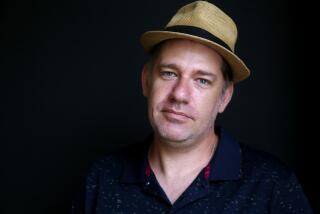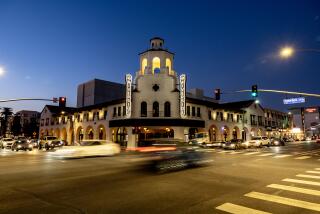Deal-Maker With a Mission : How Duane Roberts Was Able to Buy a Landmark Inn for a Song
RIVERSIDE — The Nixons were married in it. So was Bette Davis. The Reagans stayed over on their honeymoon. Other famous visitors have included Bob Hope, Ginger Rogers, William Howard Taft and Rin Tin Tin. On the other hand, Chemical Bank got robbed here, and made a Duane R. Roberts killing.
For Riverside, though, the main thing is that the scene of all this activity is back in business. The Mission Inn, a 90-year-old Spanish-inspired fantasy--nay, hallucination--formed the heart and soul of this town until the landmark hostelry closed in 1985. It was reopened last month by Roberts, a wealthy local entrepreneur who knows a good deal when he sees one.
How the Mission Inn was saved is the happy tale of a city’s heart restarted. But it’s also an object lesson in what you can do if you’re solvent--and clever--during the worst recession in Southern California since the 1930s.
Roberts, 56, has always been clever. When he was 19, back in the days when many Americans thought taco rhymed with Seiko, a Latino butcher in his family’s meat business introduced him to burritos. Roberts spent two days experimenting in the kitchen and then started selling them frozen; outlets that bought them would post a picture so people could tell what they were.
In 1980, when he sold the business, it was making a million burritos a day and had $80 million in annual sales. Since then, among other things, Roberts has bought more than 5,000 apartment units in places such as Tulsa and Wichita for less than half their replacement cost. He’s also back in frozen foods.
“It’s like my father always said,” Roberts recalls. “You want to buy when everybody else is selling. And you want to sell when everybody else is buying.”
A Riverside resident for 40 years now, Roberts knew all about the Mission Inn, having clambered all over it as a teen-ager. Built in ever more baroque stages by Frank A. Miller, a lover of Mission-style architecture, the hotel eventually came to fill the entire block between 6th, 7th, Orange and Main streets.
An indefatigable collector, Miller stuffed his labyrinthine inn with all sorts of art, antiques and bric-a-brac, including an extraordinary 18th-Century Mexican altar, a number of Tiffany windows and a Steinway piano made in 1876 to commemorate the nation’s centennial.
Miller died in 1935. After his daughter and son-in-law died in the early 1950s, the hotel changed hands a few times, often minus some more valuable furnishings, and fell increasingly into exhaustion. It closed for a major overhaul in 1985.
That project was financed by Chemical Bank. When the initial borrower went bankrupt, Chemical inherited the inn and finished the restoration in order to sell the place, plowing perhaps $50 million into the property, according to Ralph Megna, deputy director of the Riverside Redevelopment Agency. A Chemical spokesman couldn’t be reached for comment.
Just as Chemical was finishing, the hotel market collapsed and the Southern California recession was moving in like some dreaded out-of-town uncle bent on overstaying his welcome. Hardly anyone wanted an old hotel in Riverside, and those who did couldn’t get financing. Enter Duane Roberts, who practically stole the place.
Legally, of course. Roberts agreed to pay Chemical $15.6 million, but in the complicated transaction that delivered the inn to him, he put up only $1.2 million in cash. Another $1.7 million was advanced by the city’s redevelopment agency, which also contributed $2 million derived from a note repaid by Chemical and $1.3 million for a 30-year lease on a ground-floor museum.
“This property was holding the community psychologically hostage,” explains Megna. “We had to reopen it as a hotel. No one was going to believe there was a future for this community without the Mission Inn.”
Chemical Bank, capping its suffering, financed the rest of the transaction with an $11.7-million mortgage requiring no payments for the first year and interest-only payments for the next two.
What does Roberts get in the deal? A 320,000-square-foot behemoth, beautifully restored. The kitchen alone is said to be worth $1 million, and Roberts estimates that the hotel contains nearly $5 million worth of antiques and artwork. If he can hold out till the market turns around, the inn could be worth twice what he paid.
But this isn’t just an asset play. The Mission Inn is a going business again, a commercial landmark with 240 guest rooms (30 of them suites), a big dining room and patio, two lounges, a pool and two wedding chapels with a 200-couple waiting list.
Kevin Mahoney, hospitality consulting manager with Kenneth Leventhal & Co. in Century City, insists that the price Roberts paid--$65,000 a room--isn’t a steal these days. But he says Roberts made a smart move in hiring Windsor Hotel Co., which also runs the Bel-Air Hotel, to operate the Mission Inn.
Mahoney says Windsor has the creative marketing skills that the inn needs to succeed. Besides, Roberts figures the place could break even charging as little as $74 a night.
From all this a question naturally arises. If the hotel has already been restored and Windsor’s services are available for hire, who needs Roberts? In other words, why wouldn’t the bank keep the inn? Or why wouldn’t the Redevelopment Agency buy it and hire Windsor?
Well, Chemical apparently wanted to get the place off its books by year-end. As for the city, the redevelopment agency tried already. It acquired the hotel in 1976 and ran it unprofitably for nine years. Says Megna: “What we managed to prove was that government doesn’t have any role to play in the operation of a hotel.”
The moral for investors is that bad times needn’t be so bad.
“If you had some cash, there are plenty of deals like this to evaluate,” says Mahoney. “If you’re solvent.”
More to Read
Inside the business of entertainment
The Wide Shot brings you news, analysis and insights on everything from streaming wars to production — and what it all means for the future.
You may occasionally receive promotional content from the Los Angeles Times.










